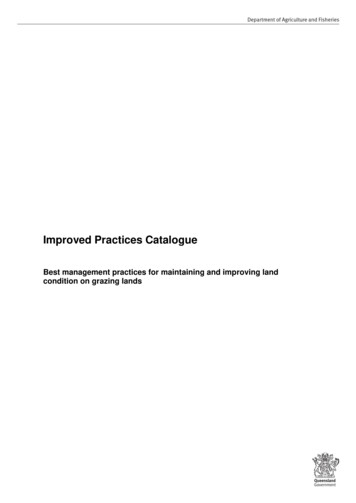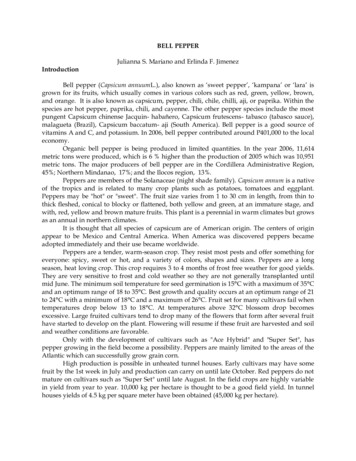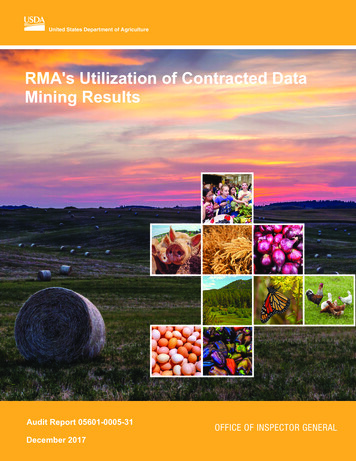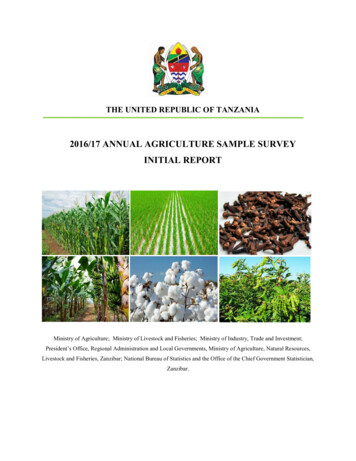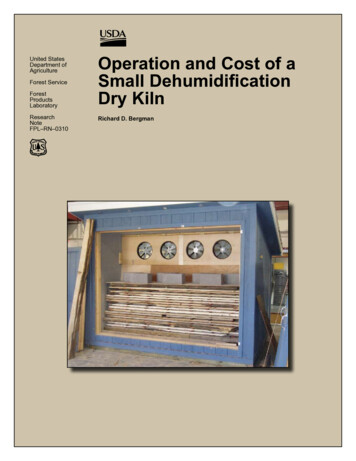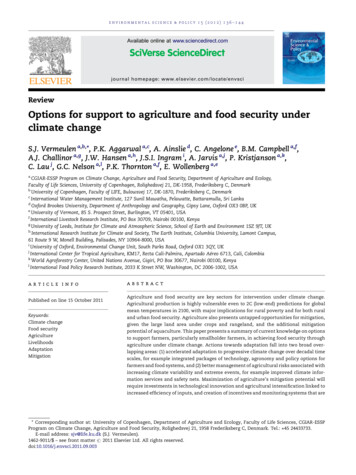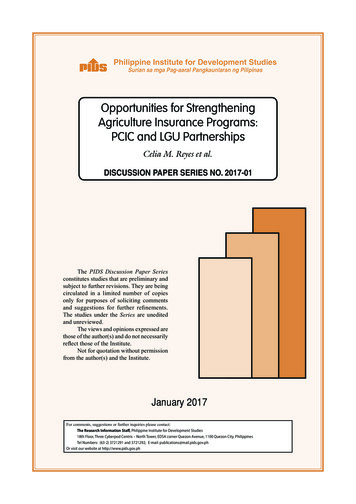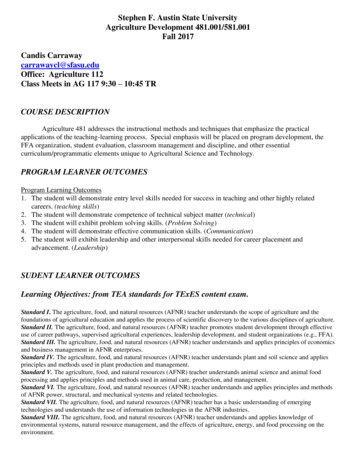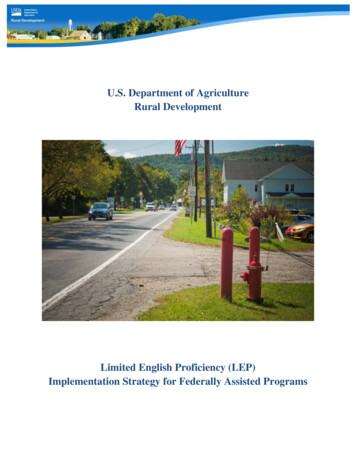
Transcription
U.S. Department of AgricultureRural DevelopmentLimited English Proficiency (LEP)Implementation Strategy for Federally Assisted Programs
Page 2 of 38
USDA Rural DevelopmentLEP Implementation Strategy for Federally Assisted ProgramsTable of ContentsPurpose. 5Policy . 5Authorities. 5Definitions/Key Terms. 6Scope . 7Background/Mission of Agency . 7Four Factor Analysis . 8Factor 1 – Step 1: Prior Experiences with LEP individuals . 8Factor 1 – Step 2: Data from the U.S. Census Bureau . 9Factor 1 – Step 3: Identify the geographic boundaries of the area served . 10Factor 1 – Step 4: Analyze the data collected . 10Factor 1 – Step 5: Outreach . 11Factor 2 – Step 1: Review the Programs . 11Factor 2 – Step 2: Consult directly with LEP persons . 11Factor 3 – Step 1: Identify Services . 11Factor 3 – Step 2: Input from Community Organizations and LEP Persons . 12Factor 4 – Step 1: Inventory. 12Factor 4 – Step 2: Determine Additional Services . 12Factor 4 – Step 3: Analyze the Budget . 13Factor 4 – Step 4: Cost Effective Practices . 13Monitoring/Evaluation . 13Initial Reviews . 13Subsequent Reviews . 14Implementing the Language Access Plan (LAP) . 14LAP Part 1: Identifying LEP Individuals Who Need Language Assistance . 15LAP Part 2: Language Assistance Measures . 16LAP Part 3: Training Staff . 16LAP Part 4: Vital Document Translations . 16LAP Part 5: Providing Notice to LEP Persons . 17LAP Part 6: Monitoring and Updating the Language Access Plan . 18Staff Training . 19Page 3 of 38
USDA Rural DevelopmentLEP Implementation Strategy for Federally Assisted ProgramsAppendices:. Error! Bookmark not defined.A - USDA LEP GUIDANCE . 20B - USDA RURAL DEVELOPMENT FEDERALLY ASSISTED PROGRAMS . 34C - LANGUAGE ASSISTANCE MONITORING CHECKLIST . 36D - LANGUAGE ASSISTANCE RESOURCES . 37Page 4 of 38
USDA Rural DevelopmentLEP Implementation Strategy for Federally Assisted ProgramsPurposeThis Implementation Strategy sets forth the recommended strategy and step-by-step proceduresfor ensuring that persons with Limited English Proficiency (LEP) have meaningful access toprograms and activities receiving Federal financial assistance from the U.S. Department ofAgriculture (USDA) Rural Development. It provides technical assistance to help recipients andsub-recipients implement USDA’s “Guidance to Federal Financial Assistance RecipientsRegarding the Title VI Prohibition Against National Origin Discrimination Affecting Personswith Limited English Proficiency” (USDA LEP Guidance) and to come into and maintaincompliance with LEP requirements. By following the recommendations and using the resourcescontained herein, recipients will be better able to prepare and implement language assistanceplans and to effectively communicate with LEP individuals who interact with their organizations.PolicyUSDA is committed to providing meaningful access to its programs and services to persons who,as a result of their national origin, are limited in English proficiency. It is USDA policy toensure no person is subjected to prohibited discrimination based on national origin in anyprogram receiving Federal financial assistance from USDA or its agencies.AuthoritiesSection 601 of Title VI of the Civil Rights Act of 1964, 42 U.S.C. 2000d et seq., and itsimplementing regulations provide that no person in the United States shall, on the grounds ofrace, color, or national origin, be excluded from participation in, be denied the benefits of, or beotherwise subjected to discrimination under any program or activity that receives Federalfinancial assistance. The Supreme Court, in Lau v. Nichols, 414 U.S. 563 (1974), interpretedTitle VI regulations promulgated by the former U.S. Department of Health, Education, andWelfare to hold that Title VI prohibits conduct that has a disproportionate effect on LEP personsbecause such conduct constitutes national origin discrimination.Executive Order 13166, “Improving Access to Services for Persons with Limited EnglishProficiency,” reprinted at 65 FR 50121 (August 16, 2000), directs each Federal agency toexamine the services it provides and develop and implement a system by which LEP persons canmeaningfully access those services. The Executive Order states that recipients must takereasonable steps to ensure meaningful access to their programs and activities by LEP persons.Federal agencies were instructed to publish guidance for their respective recipients in order toassist them with their obligations to LEP persons under Title VI. The Executive Orderrecommended uniform guidance to recipients on the preparation of a plan to improve access toits federally assisted programs and activities by eligible LEP persons. Each plan shall beconsistent with the standards set forth in the U.S. Department of Justice’s Policy GuidancePage 5 of 38
USDA Rural DevelopmentLEP Implementation Strategy for Federally Assisted ProgramsDocument entitled, “Guidance to Federal Financial Assistance Recipients Regarding Title VIProhibition Against National Origin Discrimination Affecting Limited English ProficientPersons” (“DOJ LEP Guidance”), reprinted at 67 FR 41455 (June 18, 2002). The DOJ LEPGuidance was drafted and organized to function as a model for similar guidance by other Federalagencies.Consistent with the DOJ LEP Guidance, USDA published its Final “Guidance to FederalFinancial Assistance Recipients Regarding the Title VI Prohibition Against National OriginDiscrimination Affecting Persons with Limited English Proficiency” on November 28, 2014.The Guidance does not create new obligations for recipients, but provides guidance to recipientsin meeting their existing LEP obligations. It clarifies the responsibilities of recipients and willassist them with fulfilling their responsibilities to LEP persons under Title VI and its regulations.7 CFR Part 15 Subpart A effectuates the provisions of Title VI of the Civil Rights Act of 1964(hereinafter referred to as the ‘‘Act’’) to the end that no person in the United States shall, on theground of race, color, or national origin, be excluded from participation in, be denied the benefitsof, or be otherwise subjected to discrimination under any program or activity of an applicant orrecipient receiving Federal financial assistance from the U.S. Department of Agriculture or anyAgency thereof.7 CFR Part 1901 Subpart E which contains policies and procedures for implementing theregulations of the U.S. Department of Agriculture issued pursuant to Title VI of the Civil RightsAct of 1964, Title VIII of the Civil Rights Act of 1968, Executive Order 11246, and the EqualCredit Opportunity Act of 1974, as they relate to Rural Development. Nothing herein shall beinterpreted to prohibit preference to American Indians on Indian Reservations.Definitions/Key Terms(1) Federally Assisted Programs and Activities. Programs and activities of an entity thatreceives Federal financial assistance.(2) Interpretation. The process by which the spoken word is used when transferringmeaning between languages.(3) Limited English Proficient (LEP) Persons. Persons who do not speak English as theirprimary language and have a limited ability to read, speak, write, or understandEnglish are limited English proficient, or LEP.(4) Office of Compliance, Policy, Training, and Cultural Transformation (OCPTCT).This office is responsible for the supervision and oversight of four divisions:compliance, policy, training and cultural transformation.The oversightPage 6 of 38
USDA Rural DevelopmentLEP Implementation Strategy for Federally Assisted Programsresponsibilities include the management of all work products, collaboration withUSDA agencies, quarterly and annual reports and liaison with other federal agencies.(5) Qualified Interpreter. An individual who is competent to provide interpretationservices at a level of fluency, comprehension, impartiality and confidentialityappropriate to the specific nature, type, and purpose of the information at issue.(6) Recipient. Any State, political subdivision of any State, or instrumentality of anyState or political subdivision, any public or private agency, institution, ororganization, or other entity, or any individual, in any State, to whom Federalfinancial assistance is extended, directly or through another recipient, including anysuccessor, assign, or transferee thereof, but such term does not include any ultimatebeneficiary.(7) Translation. The process of transferring ideas expressed in writing from one languageto another language.(8) Vital Document. Paper or electronic written material that contains information that iscritical for accessing a program or activity, or is required by law, such as consentforms, applications, and notices of rights.ScopeThis Implementation Strategy applies to all programs and activities receiving Federal financialassistance from the USDA Rural Development.Background/Mission of AgencyUSDA Rural Development (RD) is committed to helping improve the economy and quality oflife in rural America. Through various programs, RD helps rural Americans in many ways.RD offer loans, grants and loan guarantees to support essential services such as housing,economic development, health care, first responder services and equipment, and water, electricand communications infrastructure. RD promotes economic development by supporting loans tobusinesses through banks, credit unions and community-managed lending pools. RD offerstechnical assistance and information to help agricultural producers and cooperatives start andimprove the effectiveness of their operations. RD also provides technical assistance to helpcommunities undertake community empowerment programs and to help rural residents buy orrent safe, affordable housing and make health and safety repairs to their homes.Page 7 of 38
USDA Rural DevelopmentLEP Implementation Strategy for Federally Assisted ProgramsFour-Factor AnalysisThis section provides recipients with step-by-step suggestions for conducting an LEP needsassessment based on the four-factor analysis framework. After conducting the four-factoranalysis, USDA RD recipients will be in a better position to implement a cost-effective mix oflanguage assistance measures and to target resources appropriately. The four factors are asfollows: Factor 1: The Number and Proportion of LEP Persons Served or Encountered in theEligible Service PopulationFactor 2: The Frequency with which LEP Individuals Come into Contact with the RDFunded Programs, Activities, and ServicesFactor 3: The Importance to LEP Persons of the RD Program, Activities and ServicesFactor 4: The Resources Available to the Recipient and CostsThe steps in this section provide recipients with the means to assess their LEP needs, identifyavailable resources, and develop their language assistance plan.Factor 1 – Step 1: Prior Experiences with LEP individualsExamine prior experiences with LEP individuals. This task involves reviewing the relevantbenefits, services, and information provided by the RD funded program and determining theextent to which LEP persons have come into contact with these functions. The RD fundedprogram probably has come into contact or could come into contact with LEP persons throughone or more of the following channels: Contact with existing customer baseCalls to customer service telephone line for program servicesVisits to program officesAccess to websiteAttendance at community meetings or public hearings hosted through the RD fundedprogramProgram staff may be able to provide relevant (if anecdotal) information on how frequently theycome into contact with LEP persons. The recipient may want to contact customer servicerepresentatives and community outreach staff to obtain this information and to find out if thestaff person is able to identify the LEP persons’ native language, how successful the agency hasbeen in communicating with LEP persons, and common questions directed to the agency by LEPpersons. Consider reviewing any available records on the number of hits the program receiveson its non-English web pages or requests for interpreters at public meetings or results of anyfeedback that captures the experiences of LEP persons.Page 8 of 38
USDA Rural DevelopmentLEP Implementation Strategy for Federally Assisted ProgramsFactor 1 – Step 2: Data from the U.S. Census BureauBecome familiar with data from the U.S. Census Bureau. Data from the 2010 Census and theCensus Bureau’s American Community Survey (ACS) is currently available at www.census.gov.The 2000 Census, which was designed to measure the count of the population and housing as ofApril 1, 2000, includes data on the number of persons who indicated that they spoke English“very well,” “well,” “less than well,” and “not at all” accessed at the national, state, county,census tract, census block group, and census block level. The 2005 ACS produced a periodestimate of the characteristics of the population and housing for the period from January throughDecember of 2005. The ACS provides single-year estimates for geographic areas withpopulations of 65,000 or more and provides estimates for smaller geographic areas. Unlike the2000 Census, the 2005 ACS does not include data at the census tract, block group, or block level.As of April 2007, data on the ability to speak English is available at the state level and for somecounties. As future annual ACS surveys become available, data will become available at smallergeographic levels.The ACS includes a data set table that divides the non-English speaking element into the fourmajor language categories (“very well,” “well,” “less than well,” and “not at all”) and anadditional table that provides greater detail than the 2000 census on the specific languages ofpopulations who speak English less than very well. The ACS also provides information on theage, place of birth, citizenship status, poverty status, and educational attainment of persons whodo speak languages other than English at home.The Census Bureau collected language data in the 1980, 1990, and 2000 decennial censusesusing a series of three questions asked of the population five years old and over. The firstquestion asked if the person spoke a language other than English at home. Those who responded“yes” to this question were then asked to report the language they spoke. The Census Bureaucoded these responses into 381 detailed language categories. The third question asked how wellthat person spoke English, with answer categories of “very well,” “well,” “not well,” and “not atall.” Beginning in 2010, the questions were no longer asked on the decennial census. Thesesame three questions are now asked each year on the American Community Survey (ACS),which is the primary source of language data.Language and English-speaking ability questions that were historically collected once every tenyears in the decennial census are now captured annually in the ACS. The ACS collectsinformation from a large annual sample of approximately three million housing unit addressesand therefore provides more reliable statistics. The ACS is administered to a sample of the entireresident population, including those living in group quarters, which makes most estimates fromthe ACS comparable with those from earlier censuses. Also, the ACS provides reliable estimatesfor small levels of geography, including counties, cities, and tracts, allowing exploration of thedistribution of language use across states and metropolitan areas of the United States. Lastly,visual representation, mapping, and illustrated distributions are currently available through thePage 9 of 38
USDA Rural DevelopmentLEP Implementation Strategy for Federally Assisted ProgramsCensus Bureau’s 2011 Language Mapper Tool which pulls data from Table B16001 (Languagespoken at home by ability to speak English for the population 5 years and over).2011 Language Mapper Tool: language map.htmlFactor 1 – Step 3: Identify the geographic boundaries of the area servedIdentify the geographic boundaries of the area served by the RD funded program and obtain thecensus data on the LEP populations in that area. In some cases, the geographic boundary of theRD funded program service area is identical to the geographical boundaries of specificmunicipalities or counties. If this is the case, access census data on the LEP population at thecounty level. Additional geographies can be created by combining
assist them with fulfilling their responsibilities to LEP persons under Title VI and its regulations. 7 CFR Part 15 Subpart A effectuates the provisions of Title VI of the Civil Rights Act of 1964 (hereinafter referred to as the ‘‘Act’’) to
